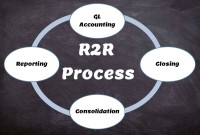- Home
- Business Processes
- Industry Knowledge
- Aerospace Industry
- Automotive Industry
- Banking Domain
- BFSI Industry
- Consumer/ FMCG Industry
- Chemicals Industry
- Engineering & Construction
- Energy Industry
- Education Domain
- Finance Domain
- Hospitality Domain
- Healthcare Industry
- Insurance Domain
- Retail Industry
- Travel and Tourism Domain
- Telecom Industry
- Leadership Skills
- eLearning
- Home
- Business Processes
- General Ledger (Record to Report)
- Defining Reporting Dimensions
Defining Reporting Dimensions
Multitude of these legal and operational structures clubbed with accounting and reporting needs give rise to many reporting dimensions at which the organization may want to track or report its operational metrics and financial results. This is where business dimensions play a vital role.
Multitude of these legal and operational structures clubbed with accounting and reporting needs give rise to many reporting dimensions at which the organization may want to track or report its operational metrics and financial results. This is where business dimensions play a vital role.
Business Dimensions:
A dimension reflects the attributes of a business, such as legal structure, management structure, departments and projects. Dimensions are used to help capture and analyze underlying data and when used with reporting provides an effective tool to break down key components of business to help make better business decisions. Business dimensions describe the business-specific objects within the model, such as products, customers, regions, employees, and so on.
Why we need business dimensions:
In any typical entity, accounting process starts with recording of a transaction that has a financial implication on a voucher and it culminates with the preparation of final books of accounts. However this simple process gains complexity when the size of the organization and diversity of its environment increases. For example: Global companies regularly distribute goods from a central site to customers located in different countries or regions. Before shipping lo a customer, goods may be processed through a separate operating unit or subsidiary in the country of sales origin. A complex sequence of coupled accounting records is needed because these transactions impact multiple organizations and legal entities, and most governments require a financial record for transactions conducted between legal entities. Management need to contemplate these business dimensions properly for decision-making and enhancing the achievement of the competitive advantage and control over the operations of the enterprise.
- There exist various types of entities or business units which are part of the same global group.
- These units may represent countries, locations, businesses, functions, projects, cost centers, segments etc.
- These units may have different reporting needs.
- These units may be responsible for their own profit and loss.
- They might be holding their own Fixed Assets.
- They might be concerned with their own markets where their products are sold.
- They might be constituted as separate legal entities over multiple layers of ownership with their peculiar independent local statutory reporting needs.
- Subsidiaries and branches operating as individual entities need to be consolidated with the group financials.
Examples of different dimensions are:
- Legal Entity: Financial results and trial balance at each legal entity level
- Division/Department: Financial results and trial balance at each division or department
- Product Line: Operating margins for each product line
- Geography: Annual Growth for each geography in which a company operates
- Project: Cost and profitability for each project undertaken by business
- Cost Center: Costs accumulated and allocated through each cost center
- Accounts: Total fixed assets owned by the legal entity, accounted under land and building, furniture and fixtures and other accounts
- Functional Area: Total cost attributable to each function like finance, marketing etc.
These dimensions further have parent child relationships within themselves and other corporate relationships (known as Business Hierarchies) with other dimensions. Corporate relationships are the links between various dimensions like parent companies, subsidiaries, headquarters, branches, functions, product lines, cost centers etc. A dimension may consists of one or more hierarchies that can contain several levels.
Related Links
You May Also Like
-
Learn the typical accounting cycle that takes place in an automated accounting system. We will understand the perquisites for commencing the accounting cycle and the series of steps required to record transactions and convert them into financial reports. This accounting cycle is the standard repetitive process that is undertaken to record and report accounting.
-
Record to report (R2R) is a finance and accounting management process that involves collecting, processing, analyzing, validating, organizing, and finally reporting accurate financial data. R2R process provides strategic, financial, and operational feedback on the performance of the organization to inform management and external stakeholders. R2R process also covers the steps involved in preparing and reporting on the overall accounts.
-
The purpose of the general ledger is to sort transaction information into meaningful categories and charts of accounts. The general ledger sorts information from the general journal and converts them into account balances and this process converts data into information, necessary to prepare financial statements. This article explains what a general ledger is and some of its major functionalities.
-
As the business grows, the company may want to transition to a branch structure as branches are allowed to conduct a much broader range of activity than representative offices. Branches can buy and sell goods, sign contracts, build things, render services, and generally everything that a regular business can do. A company expands its business by opening up its branch offices in various parts of the country as well as in other countries.
-
Trial Balance in General Ledger
One of the greatest benefits of using a double-entry accounting system is the capability to generate a trial balance. What do we mean by trial balance? As the name suggests a trial balance is a report that must have its debits equals to credits. Understand the importance of trial balance and why it is balanced. Learn how it is prepared and in which format.
-
GL - Review & Approve Journals
Review and Approval mechanisms ensure that the accounting transaction is reasonable, necessary, and comply with applicable policies. Understand why we need review and approval processes, what are they, and how they are performed in automated general ledger systems. Learn the benefits of having journal approval mechanisms in place.
-
This article explains the process of entering and importing general ledger journals in automated accounting systems. Learn about the basic validations that must happen before the accounting data can be imported from any internal or external sub-system to the general ledger. Finally, understand what we mean by importing in detail or in summary.
-
In most of the automated financial systems, you can define more than 12 accounting periods in a financial year. This article will explain the concept of the adjustment period and the benefits of having adjustment periods. Adjustment periods have their inherent challenges for the users of financial statements and there is a workaround for those who don’t want to use adjustment periods.
-
Divisional Organizational Structures
The divisional structure or product structure consists of self-contained divisions. A division is a collection of functions which produce a product. It also utilizes a plan to compete and operate as a separate business or profit center. Divisional structure is based on external or internal parameters like product /customer segment/ geographical location etc.
-
GL - Understanding Chart of Accounts
A chart of accounts (COA) is a list of the accounts used by a business entity to record and categorize financial transactions. COA has transitioned from the legacy accounts, capturing just the natural account, to modern-day multidimensional COA structures capturing all accounting dimensions pertaining to underlying data enabling a granular level of reporting. Learn more about the role of COA in modern accounting systems.
Explore Our Free Training Articles or
Sign Up to Start With Our eLearning Courses

About Us
Learning
© 2023 TechnoFunc, All Rights Reserved











